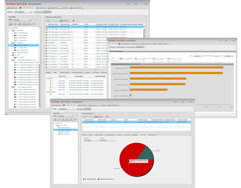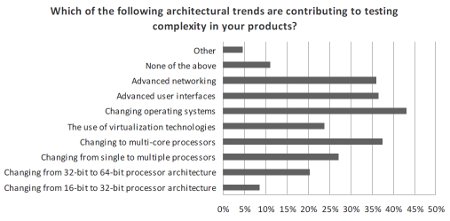Wind River revs test management framework
Jun 9, 2010 — by Eric Brown — from the LinuxDevices Archive — 3 viewsWind River has released a new version of its test automation framework for embedded device software testing, and also released survey results on embedded development challenges. Wind River Test Management 3.3 is said to improve multicore support, expand run-time test coverage, add a hybrid test type, and debut a new component-based test model.
Introduced in July 2008, Wind River Test Management is billed as a dynamic analytics technology that enables run-time visibility into devices during testing. The software provides feedback that product teams can use to reduce testing time and costs while improving quality, says Wind River.
The Linux-ready testing framework combines a scalable test execution engine, an embedded device virtual lab manager, and dynamic software instrumentation technology, says Wind River. The software can be deployed as a stand-alone system or can be integrated via open interfaces with commercial tools, such as Wind River Linux, or with internally developed test environments, says the Intel subsidiary.

Wind River Test Management 3.3
In addition, the software supports iterative or agile testing methods enabling repeated testing of intermediate releases, says the company.
Major enhancements to Wind River Test Management 3.3 are said to include:
- Scalability of run-time test coverage for monitoring very large applications has been improved by 10 times, says Wind River.
- Features have been added to track code churn and enable change-based test automation to streamline iterative and agile testing.
- A new hybrid test type combines manual and scripted steps to allow sophisticated, hybrid device test sequences and facilitate migration to fully automated testing.
- A new component-based test model with file attachments allows development of more self-contained, data-driven, modular, and maintainable tests.
- Improved support for multicore devices and multidevice test beds enables complex parallel testing and runtime data collection while simplifying lab device management, says the company.
Wind River Test Management can be used in conjunction with IBM Rational Quality Manager, IBM's quality management life cycle solution based on the IBM Rational Jazz platform, says Wind River. IBM and Wind River are collaborating on a joint embedded software lifecycle quality management solution based on the two platforms.
Survey highlights embedded device testing headaches
Today, Wind River also released survey findings from a poll of 900 industry professionals, examining software quality testing in the embedded industry. The results are said to reflect market trends that are making developing and testing software quality increasingly difficult.
Challenges include the growth of software and device complexity, lack of strong visibility into software quality, and ever tightening product deadlines, says Wind River. The figure below suggests that OS porting is one of the thorniest embedded development challenges, followed by multicore obstacles, and then networking and UI issues. (See link to the survey farther below.)

A figure from Wind River's survey on embedded device development and testing challenges
(Source: Wind River)
(Click to enlarge)
Stated Tim Staggs, senior manager of product test automation at LSI, "We've selected Wind River Test Management to help us get a clearer picture of how thoroughly we are testing our storage system software, and to reduce the number of tests required to validate each release."
Availability
Wind River Test Management 3.3 will be available on June 11, says Wind River. More information may be found here.
A PDF of the Wind River survey on embedded development and testing challenges may be found here.
This article was originally published on LinuxDevices.com and has been donated to the open source community by QuinStreet Inc. Please visit LinuxToday.com for up-to-date news and articles about Linux and open source.